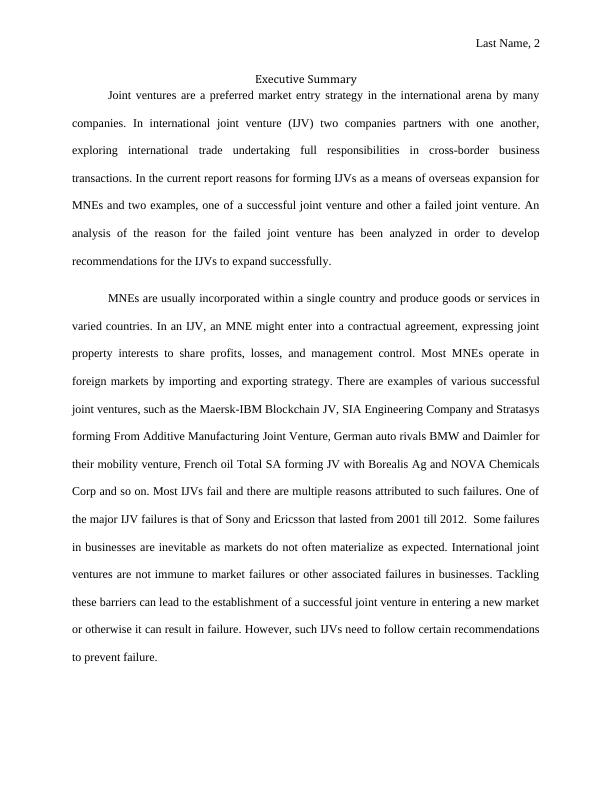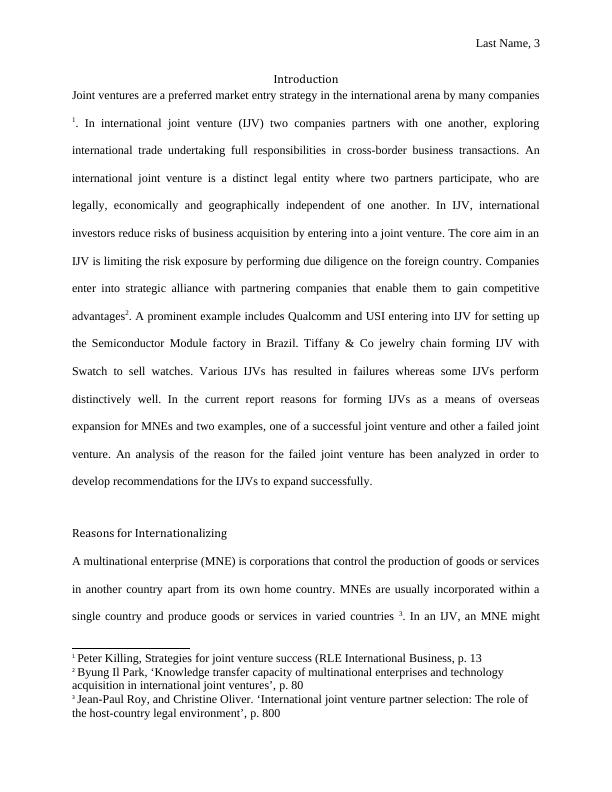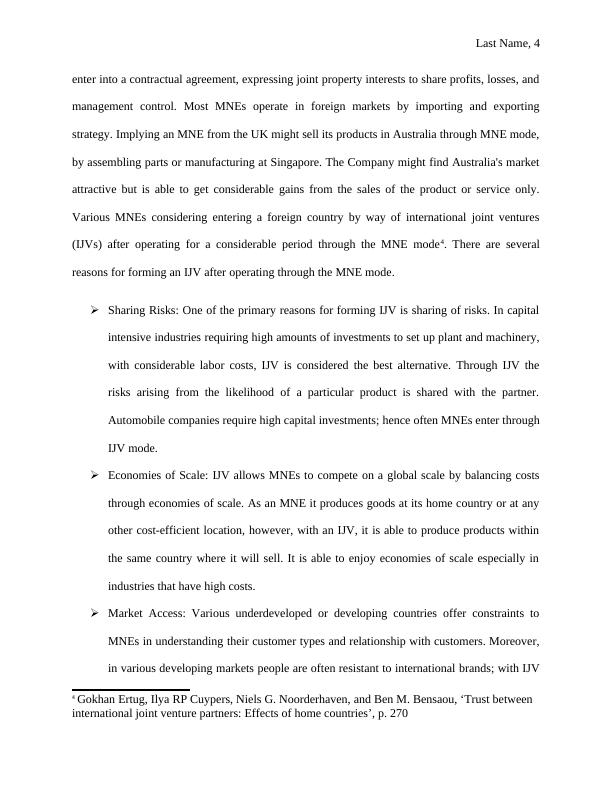International Joint Ventures success and failures
Added on 2023-01-19
13 Pages3591 Words35 Views
Last Name, 1
International Joint Ventures success and failures
Student Name
Subject Name, Code
Professor Name
Date
International Joint Ventures success and failures
Student Name
Subject Name, Code
Professor Name
Date

Last Name, 2
Executive Summary
Joint ventures are a preferred market entry strategy in the international arena by many
companies. In international joint venture (IJV) two companies partners with one another,
exploring international trade undertaking full responsibilities in cross-border business
transactions. In the current report reasons for forming IJVs as a means of overseas expansion for
MNEs and two examples, one of a successful joint venture and other a failed joint venture. An
analysis of the reason for the failed joint venture has been analyzed in order to develop
recommendations for the IJVs to expand successfully.
MNEs are usually incorporated within a single country and produce goods or services in
varied countries. In an IJV, an MNE might enter into a contractual agreement, expressing joint
property interests to share profits, losses, and management control. Most MNEs operate in
foreign markets by importing and exporting strategy. There are examples of various successful
joint ventures, such as the Maersk-IBM Blockchain JV, SIA Engineering Company and Stratasys
forming From Additive Manufacturing Joint Venture, German auto rivals BMW and Daimler for
their mobility venture, French oil Total SA forming JV with Borealis Ag and NOVA Chemicals
Corp and so on. Most IJVs fail and there are multiple reasons attributed to such failures. One of
the major IJV failures is that of Sony and Ericsson that lasted from 2001 till 2012. Some failures
in businesses are inevitable as markets do not often materialize as expected. International joint
ventures are not immune to market failures or other associated failures in businesses. Tackling
these barriers can lead to the establishment of a successful joint venture in entering a new market
or otherwise it can result in failure. However, such IJVs need to follow certain recommendations
to prevent failure.
Executive Summary
Joint ventures are a preferred market entry strategy in the international arena by many
companies. In international joint venture (IJV) two companies partners with one another,
exploring international trade undertaking full responsibilities in cross-border business
transactions. In the current report reasons for forming IJVs as a means of overseas expansion for
MNEs and two examples, one of a successful joint venture and other a failed joint venture. An
analysis of the reason for the failed joint venture has been analyzed in order to develop
recommendations for the IJVs to expand successfully.
MNEs are usually incorporated within a single country and produce goods or services in
varied countries. In an IJV, an MNE might enter into a contractual agreement, expressing joint
property interests to share profits, losses, and management control. Most MNEs operate in
foreign markets by importing and exporting strategy. There are examples of various successful
joint ventures, such as the Maersk-IBM Blockchain JV, SIA Engineering Company and Stratasys
forming From Additive Manufacturing Joint Venture, German auto rivals BMW and Daimler for
their mobility venture, French oil Total SA forming JV with Borealis Ag and NOVA Chemicals
Corp and so on. Most IJVs fail and there are multiple reasons attributed to such failures. One of
the major IJV failures is that of Sony and Ericsson that lasted from 2001 till 2012. Some failures
in businesses are inevitable as markets do not often materialize as expected. International joint
ventures are not immune to market failures or other associated failures in businesses. Tackling
these barriers can lead to the establishment of a successful joint venture in entering a new market
or otherwise it can result in failure. However, such IJVs need to follow certain recommendations
to prevent failure.

Last Name, 3
Introduction
Joint ventures are a preferred market entry strategy in the international arena by many companies
1. In international joint venture (IJV) two companies partners with one another, exploring
international trade undertaking full responsibilities in cross-border business transactions. An
international joint venture is a distinct legal entity where two partners participate, who are
legally, economically and geographically independent of one another. In IJV, international
investors reduce risks of business acquisition by entering into a joint venture. The core aim in an
IJV is limiting the risk exposure by performing due diligence on the foreign country. Companies
enter into strategic alliance with partnering companies that enable them to gain competitive
advantages2. A prominent example includes Qualcomm and USI entering into IJV for setting up
the Semiconductor Module factory in Brazil. Tiffany & Co jewelry chain forming IJV with
Swatch to sell watches. Various IJVs has resulted in failures whereas some IJVs perform
distinctively well. In the current report reasons for forming IJVs as a means of overseas
expansion for MNEs and two examples, one of a successful joint venture and other a failed joint
venture. An analysis of the reason for the failed joint venture has been analyzed in order to
develop recommendations for the IJVs to expand successfully.
Reasons for Internationalizing
A multinational enterprise (MNE) is corporations that control the production of goods or services
in another country apart from its own home country. MNEs are usually incorporated within a
single country and produce goods or services in varied countries 3. In an IJV, an MNE might
1 Peter Killing, Strategies for joint venture success (RLE International Business, p. 13
2 Byung Il Park, ‘Knowledge transfer capacity of multinational enterprises and technology
acquisition in international joint ventures’, p. 80
3 Jean-Paul Roy, and Christine Oliver. ‘International joint venture partner selection: The role of
the host-country legal environment’, p. 800
Introduction
Joint ventures are a preferred market entry strategy in the international arena by many companies
1. In international joint venture (IJV) two companies partners with one another, exploring
international trade undertaking full responsibilities in cross-border business transactions. An
international joint venture is a distinct legal entity where two partners participate, who are
legally, economically and geographically independent of one another. In IJV, international
investors reduce risks of business acquisition by entering into a joint venture. The core aim in an
IJV is limiting the risk exposure by performing due diligence on the foreign country. Companies
enter into strategic alliance with partnering companies that enable them to gain competitive
advantages2. A prominent example includes Qualcomm and USI entering into IJV for setting up
the Semiconductor Module factory in Brazil. Tiffany & Co jewelry chain forming IJV with
Swatch to sell watches. Various IJVs has resulted in failures whereas some IJVs perform
distinctively well. In the current report reasons for forming IJVs as a means of overseas
expansion for MNEs and two examples, one of a successful joint venture and other a failed joint
venture. An analysis of the reason for the failed joint venture has been analyzed in order to
develop recommendations for the IJVs to expand successfully.
Reasons for Internationalizing
A multinational enterprise (MNE) is corporations that control the production of goods or services
in another country apart from its own home country. MNEs are usually incorporated within a
single country and produce goods or services in varied countries 3. In an IJV, an MNE might
1 Peter Killing, Strategies for joint venture success (RLE International Business, p. 13
2 Byung Il Park, ‘Knowledge transfer capacity of multinational enterprises and technology
acquisition in international joint ventures’, p. 80
3 Jean-Paul Roy, and Christine Oliver. ‘International joint venture partner selection: The role of
the host-country legal environment’, p. 800

Last Name, 4
enter into a contractual agreement, expressing joint property interests to share profits, losses, and
management control. Most MNEs operate in foreign markets by importing and exporting
strategy. Implying an MNE from the UK might sell its products in Australia through MNE mode,
by assembling parts or manufacturing at Singapore. The Company might find Australia's market
attractive but is able to get considerable gains from the sales of the product or service only.
Various MNEs considering entering a foreign country by way of international joint ventures
(IJVs) after operating for a considerable period through the MNE mode4. There are several
reasons for forming an IJV after operating through the MNE mode.
Sharing Risks: One of the primary reasons for forming IJV is sharing of risks. In capital
intensive industries requiring high amounts of investments to set up plant and machinery,
with considerable labor costs, IJV is considered the best alternative. Through IJV the
risks arising from the likelihood of a particular product is shared with the partner.
Automobile companies require high capital investments; hence often MNEs enter through
IJV mode.
Economies of Scale: IJV allows MNEs to compete on a global scale by balancing costs
through economies of scale. As an MNE it produces goods at its home country or at any
other cost-efficient location, however, with an IJV, it is able to produce products within
the same country where it will sell. It is able to enjoy economies of scale especially in
industries that have high costs.
Market Access: Various underdeveloped or developing countries offer constraints to
MNEs in understanding their customer types and relationship with customers. Moreover,
in various developing markets people are often resistant to international brands; with IJV
4 Gokhan Ertug, Ilya RP Cuypers, Niels G. Noorderhaven, and Ben M. Bensaou, ‘Trust between
international joint venture partners: Effects of home countries’, p. 270
enter into a contractual agreement, expressing joint property interests to share profits, losses, and
management control. Most MNEs operate in foreign markets by importing and exporting
strategy. Implying an MNE from the UK might sell its products in Australia through MNE mode,
by assembling parts or manufacturing at Singapore. The Company might find Australia's market
attractive but is able to get considerable gains from the sales of the product or service only.
Various MNEs considering entering a foreign country by way of international joint ventures
(IJVs) after operating for a considerable period through the MNE mode4. There are several
reasons for forming an IJV after operating through the MNE mode.
Sharing Risks: One of the primary reasons for forming IJV is sharing of risks. In capital
intensive industries requiring high amounts of investments to set up plant and machinery,
with considerable labor costs, IJV is considered the best alternative. Through IJV the
risks arising from the likelihood of a particular product is shared with the partner.
Automobile companies require high capital investments; hence often MNEs enter through
IJV mode.
Economies of Scale: IJV allows MNEs to compete on a global scale by balancing costs
through economies of scale. As an MNE it produces goods at its home country or at any
other cost-efficient location, however, with an IJV, it is able to produce products within
the same country where it will sell. It is able to enjoy economies of scale especially in
industries that have high costs.
Market Access: Various underdeveloped or developing countries offer constraints to
MNEs in understanding their customer types and relationship with customers. Moreover,
in various developing markets people are often resistant to international brands; with IJV
4 Gokhan Ertug, Ilya RP Cuypers, Niels G. Noorderhaven, and Ben M. Bensaou, ‘Trust between
international joint venture partners: Effects of home countries’, p. 270

End of preview
Want to access all the pages? Upload your documents or become a member.
Related Documents
International Joint Ventureslg...
|16
|3781
|22
International Business Strategy: IJVlg...
|10
|2964
|399
International Joint Ventureslg...
|16
|4826
|23
Impact of International Joint Ventures on Organizations in Chinalg...
|13
|3435
|397
International Construction: Joint Venture between an International Developer and Government Agencylg...
|20
|5356
|76
Cross Cultural Managementlg...
|12
|3198
|200
